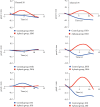Unveiling Cognitive Interference: fNIRS Insights Into Poststroke Aphasia During Stroop Tasks
- PMID: 40201621
- PMCID: PMC11976049
- DOI: 10.1155/np/1456201
Unveiling Cognitive Interference: fNIRS Insights Into Poststroke Aphasia During Stroop Tasks
Abstract
This study examined blood oxygenation changes during a modified Stroop task with colored Chinese words using functional near-infrared spectroscopy (fNIRS) in patients with poststroke aphasia. The task included three conditions: neutral, congruent, and incongruent. Participants consisted of 15 healthy adults and 15 patients with poststroke aphasia. Compared to healthy adults, aphasic patients showed significantly longer reaction times and reduced accuracy across all conditions, with a more pronounced interference effect in the incongruent condition. fNIRS analysis revealed distinct neurophysiological differences: decreased activation in Broca's area, increased activation in the ventromedial frontal pole, and atypical recruitment of the left dorsolateral prefrontal cortex (DLPFC) during Stroop interference tasks. These findings highlight the differing neural mechanisms underlying cognitive interference in poststroke aphasia. The integration of fNIRS with the Stroop task enhances our understanding of intentional inhibition deficits and the impact of cognitive interference in aphasic patients. Importantly, these results suggest that deficits in cognitive control and abnormalities in prefrontal regions, such as the frontal pole and DLPFC, may be potential targets for noninvasive neuromodulation to improve cognitive control in poststroke aphasia. The observed atypical activation patterns in these regions underscore their critical role in managing cognitive interference and intentional inhibition. Noninvasive brain modulation techniques may offer promising strategies for modulating these neural mechanisms. This study underscores the need for targeted interventions that address prefrontal dysfunctions and emphasizes the value of visual language tasks in exploring the complex relationship between language deficits and cognitive control in this population.
Keywords: Stroop task; aphasia; functional near-infrared spectroscopy.
Copyright © 2025 Chong Lu et al. Neural Plasticity published by John Wiley & Sons Ltd.
Conflict of interest statement
The authors declare no conflicts of interest.
Figures




References
Publication types
MeSH terms
LinkOut - more resources
Full Text Sources
Medical

